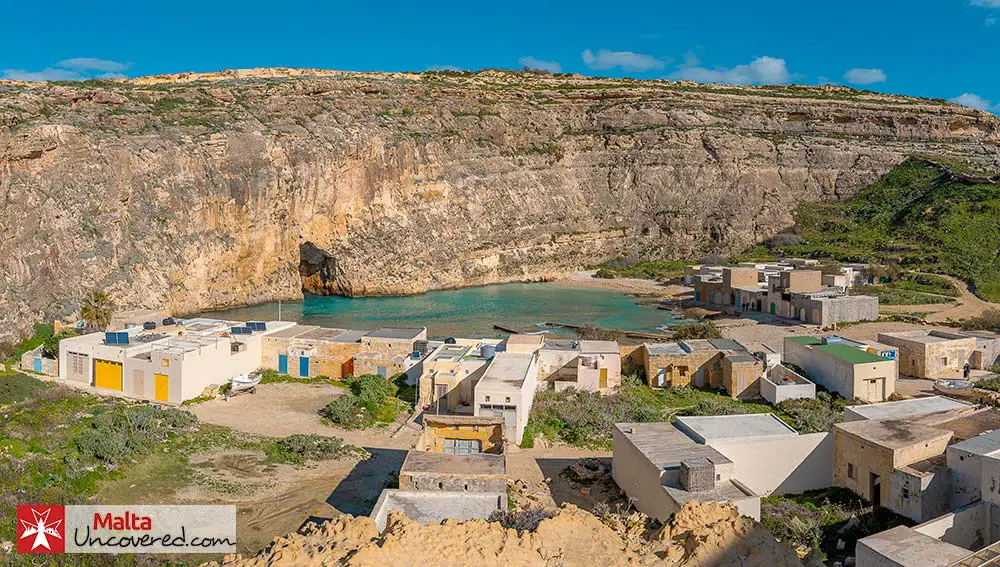Home » Gozo Island » Dwejra, Gozo
Dwejra is a small location on the West coast of the island of Gozo, known for its “inland sea” (small bay surrounded by high cliffs) and as the site where the Azure Window (naturally formed rock arch on the coast) once stood proudly.
A little further South, the wide open bay where you can find Fungus Rock is officially called Dwejra Bay and is “guarded” by a watch tower built by the Knights of Malta.
The name Dwejra comes from a small house that once stood on top of the cliffs surrounding the inland sea. With its unique natural features, Dwejra Bay is a popular destination for tourists, local snorkellers and divers. The bay is home to rich and diverse wildlife and underwater features and has a very rugged feel.
It’s one of my favourite places to spend time in Gozo and is listed on my list of 25+ Things to do in Gozo.

Looking to sightsee in Gozo? Check out the chauffeured Tuk-Tuk tours and self-drive tours by Quad bike at Yippee for a fun day out in Gozo!
Use coupon code MALTA5 and get 5% off!

Although you can reach Dwejra Bay by public transport (bus route 311 from Victoria Gozo), it’s far easier to reach with a rental car, which is recommended anyway if you’re looking to discover Gozo Island as a whole. You will find a free car park on-site.
Local tip: If you are using Google Maps as a navigation tool, set “Azure Window” rather than “Dwejra Bay” because the main parking area at Dwejra is located further down the road, a little further North of Dwejra Bay. You need to drive through the centre of San Lawrenz (village) before you get to Dwejra Gozo.
Don’t plan on renting a car? Have a look at chauffeured or self-drive tours with Yippee – Lots of fun and highly recommended! More info here: Gozo Tuk Tuk and Gozo Quad Biking tours.
Get my recommendations on the best day trips, boat trips, excursions and activities and book in advance!

The inland sea at Dwejra is a relatively small bay surrounded by high cliffs and connected by an 80-metre-long cave that leads you out to the open sea. It’s truly a place that evokes awe, and that leaves an impression.
Several small boathouses can be found along the shoreline, housing the locals’ fishing boats.
You can take a short boat trip through the sea cave, out to the open sea and the nearby Fungus Rock. The boat tour costs €5 per person for a duration of 15-20 minutes. Boat trips are operating every day (including public holidays), except when the sea is rough.
The departure of the boat trip is located on the pebbled beach of the inland sea. The boat leaves the inland sea and goes through the tunnel leading to the open Mediterranean Sea.
Then, you will see rock formations, whose one is said to look like a crocodile. The captain will show you different caves, rocks, and the impressive cliff face and tell you some funny stories about them. The boat tours also take you to caves reminding you a bit of the Blue Grotto in Malta.
Pros
Cons
The “Inland Sea” at Dwejra is one of the best beaches in Gozo (in my book, at least!)

Check out my two guidebooks full of local knowledge and my best recommendations for your trip, and up-to-date for 2024!
Malta & Gozo guide book
Valletta: An Insider’s Guide to Malta’s Capital
Take the hassle out of planning your trip to Malta and be an informed traveller!
The Azure Window at Dwejra was one of the most popular tourist attractions that Gozo Island had to offer until March 2017. Since the early 2000s, it became more obvious that rough weather and natural erosion were taking their toll on the structure. Several pieces had broken off, and the top of the arch looked increasingly fragile.
Several geological studies concluded that there was no feasible way to keep the Azure Window from eventually (partially) collapsing, with the top of the arch being the primary reason for concern.
As we learned in March 2017, during a spell of bad weather and very rough seas, its column turned out to be the weakest part, with the whole structure collapsing into the sea.
The day will be remembered by many locals, and I will myself as well. Sure, it was just a rock formation, and its days were numbered, but somehow the Maltese and particularly the Gozitans grew up with the Azure Window being an icon of Malta and had grown very fond of it.
Considering the events, there are a few positives:
Still want to get an idea of what Azure Window looked like? Head to Wied il-Mielaħ, located in the north of Għarb. This natural arch might not be as big and impressive as the Dwejra Window was once, but it’s still a beautiful place and a natural gem.
Wied il-Mielaħ is still not very touristy, and for that reason, it is less easily accessible than Dwejra Bay. It is located at the end of a narrow road lined with terraced fields and can only be reached by car (unless you are into hiking – in that case, you can walk from Għarb or Ta’ Pinu). To watch the window itself, you need to climb down the stairs.
Fungus Rock, known locally as Il-Ġebla tal-Ġeneral (The General’s Rock), is a 60-metre high rock feature in Dwejra Bay that is known for a particular type of flowery plant that was thought to possess healing properties in the times of the Knights of St. John and was therefore considered to be precious and of high value. The unauthorised access was punishable by death or life on the galleys, and to make climbing the rock more difficult, Grandmaster de Pinto ordered the sides of the rock to be smoothed over.
Despite its common name (its Latin name being Cynomorium coccineum), this rare species of plant isn’t actually a fungus, although its shape would easily make you believe it is. Because the plant is found mostly on Fungus Rock, the location is a nature reserve nowadays.
The Blue Hole refers to a natural, 10-meter-wide inland sea pool right in front of the former location of the Azure Window at Dwejra Bay. The Blue Hole leads into a deep crevice that opens up into the open sea, making it a popular dive site for local and foreign diving enthusiasts alike. The site is home to several species of fish and other underwater fauna, such as parrotfish, bream, Moray eel, lobster, octopus and much more.
If you are planning to swim or snorkel in the Blue Hole, note that it is dangerous when the sea is rough. In case of windy or rough weather, prefer swimming in the inland sea instead.
Dwejra Tower, one of the Knights’ coastal watchtowers, sits on a vantage point overlooking Fungus Rock. Used as a method of guarding the coast of the Maltese islands against attacks from the sea, this particular tower was built in 1652 during the reign of Grandmaster Lascaris.
The purpose of the watchtower was to give warnings of enemy approaches, such as pirates and corsairs. When such approaches were sighted, the men inside could signal other watchtowers by using fire at night or smoke during the day.
The Dwejra watchtower was built on a square base with two floors and a turret on the roof from where you can admire the fantastic views of the surrounding area. Before the steep external steps were built, the only way to get into the tower was via a retractable ladder through the top floor–this offered security to the men inside in case the enemy managed to make a landing.

The top floor served as a guardroom and living quarters for a garrison of up to four men. The basement was used for storage, while a small gunpowder store was kept on the roof. A water reservoir was dug into the rock underneath the tower.
During the times of the Knights, the salt pans in front of the Tower served to raise money to cover maintenance costs for the tower.
After the period of the Knights, the strategic position of the tower ensured that it was not abandoned. It was used during the 18th century and later manned by the Royal Malta Fencible Artillery between 1839 and 1873.
During the summer of 1914, Maltese troops from the King’s Own Malta Regiment and the Royal Malta Artillery were dispatched to the coastal watchtowers and Dwejra Tower was manned by No. 3 Company.
During the Second World War, the Tower was used by the British as an Observation Post.
The tower is accessible to the public all year round, on Sundays from 10:30 a.m. to 3:30 p.m. It’s easy to confirm that the tower is open to visitors, with a flag being flown atop the structure during opening hours.
The Azure Window collapsed because of a storm in March 2017. In the previous years, it was becoming weaker and weaker due to natural erosion and rough weather, to which Dwejra Bay is easily exposed.
Now, the Azure Window doesn’t look like an arch anymore, and the only remaining part is the cliff on the right. The place is still really beautiful, though. Under the sea level, the remains of the Azure Window made the site even more attractive for divers.
The Blue Hole in Gozo is 15 meters deep and is one of the most famous scuba diving sites in Malta.
There are facilities and a restaurant called Azure Window at Dwejra Gozo. Other eating and snack options include a food truck specialising in pizza and other trucks selling ice creams and cold drinks.
There are also free public parking, a bus stop (Dwejra), a small souvenir shop, public toilets near the St. Anna chapel, a dive club and the Dwejra Marine Environmental Education Centre.

Edward is the Founder and Editor of Malta Uncovered and author of two guidebooks on Malta and Valletta.
As a tourist-turned-expat with Maltese roots, he knows the islands inside out and helps thousands of visitors enjoy a memorable trip every year.
Get the best travel tips from Malta Uncovered delivered to you in bite-sized chunks by email. (Unsubscribe at any time!)
Was this article helpful? Share it with your friends!
Get the most out of your visit to Malta with Malta Uncovered guidebooks – full of local knowledge and up-to-date for 2024!
